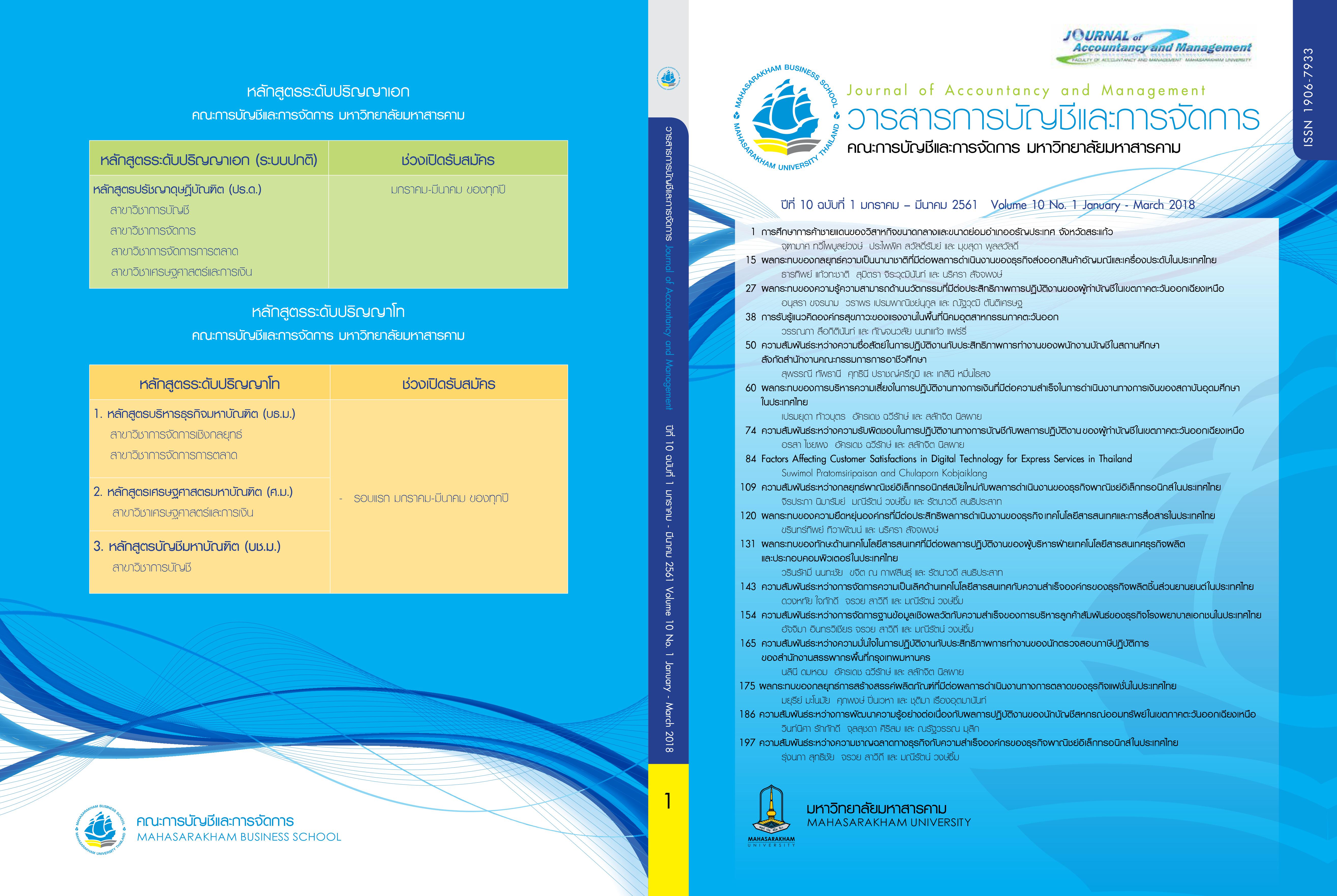ผลกระทบของกลยุทธ์การสร้างสรรค์ผลิตภัณฑ์ที่มีต่อผลการดำเนินงาน ทางการตลาดของธุรกิจแฟชั่นในประเทศไทย
Main Article Content
บทคัดย่อ
การวิจัยครั้งนี้ มีวัตถุประสงค์เพื่อศึกษา ผลกระทบของกลยุทธ์การสร้างสรรค์ผลิตภัณฑ์ที่มีต่อผลการดำเนินงานทางการตลาดของธุรกิจแฟชั่นในประเทศไทย โดยใช้แบบสอบถามเป็นเครื่องมือในการเก็บรวบรวมจากผู้บริหารฝ่ายการตลาดของธุรกิจแฟชั่นในประเทศไทย จำนวน 101 คน สถิติที่ใช้ในการวิเคราะห์ข้อมูล ได้แก่ การวิเคราะห์สหสัมพันธ์พหุคูณ การวิเคราะห์การถดถอยอย่างง่าย และการวิเคราะห์การถดถอยพหุคูณ ผลการวิจัย พบว่า กลยุทธ์การสร้างสรรค์ผลิตภัณฑ์ ด้านการกลั่นกรองความคิด ด้านการพัฒนากลยุทธ์ทางการตลาด และด้านการพัฒนาผลิตภัณฑ์ มีความสัมพันธ์และผลกระทบเชิงบวกกับผลการดำเนินงานทางการตลาด ดังนั้น ผลลัพธ์ที่ได้จากการวิจัยนี้ ผู้บริหารธุรกิจแฟชั่นสามารถนำไปใช้เป็นแนวทางสำหรับการกำหนดกลยุทธ์การสร้างสรรค์ผลิตภัณฑ์ให้สามารถตอบสนองต่อความต้องการของลูกค้าได้อย่างสูงสุด อันจะนำไปสู่ผลการดำเนินงานทางการตลาดที่มีประสิทธิภาพและประสิทธิผล เพื่อสร้างความได้เปรียบทางการแข่งขันที่อย่างยั่งยืนต่อไปในอนาคต
Downloads
Article Details
บทความที่ได้รับการตีพิมพ์เป็นลิขสิทธิ์ของวารสารการบัญชีและการจัดการ
ข้อความที่ปรากฏในบทความแต่ละเรื่องในวารสารวิชาการเล่มนี้เป็นความคิดเห็นส่วนตัวของผู้เขียนแต่ละท่านไม่เกี่ยวข้องกับมหาวิทยาลัยมหาสารคาม และคณาจารย์ท่านอื่นๆในมหาวิทยาลัยฯ แต่อย่างใด ความรับผิดชอบองค์ประกอบทั้งหมดของบทความแต่ละเรื่องเป็นของผู้เขียนแต่ละท่าน หากมีความผิดพลาดใดๆ ผู้เขียนแต่ละท่านจะรับผิดชอบบทความของตนเองแต่ผู้เดียว
เอกสารอ้างอิง
กรมส่งเสริมอุตสาหกรรม. (2558). ค้นเมื่อ 26 พฤศจิกายน 2559, จาก http://www.komchadluek.net/news/lifestyle/218612
ชาคร อ่อนฉวี. (2558). ผลกระทบของประสิทธิภาพการพัฒนาผลิตภัณฑ์ใหม่ที่มีต่อผลการดาเนินงานของธุรกิจสิ่งทอและเครื่องนุ่งห่มในภาคกลาง. วิทยานิพนธ์ บธ.ม. มหาสารคาม : มหาวิทยาลัยมหาสารคาม.
ดนัย เทียนพุฒ. (2545). ดัชนีวัดผลสำเร็จ (Key Performance Indicators : KPI ). กรุงเทพฯ : ซีเอ็ดยูเคชั่น.
นภวรรณ คณานุรักษ์. (2555). กระบวนการพัฒนาผลิตภัณฑ์ใหม่. กรุงเทพฯ : คณะบริหารธุรกิจ มหาวิทยาลัยหอการค้าไทย.
บุญชม ศรีสะอาด. (2545). การวิจัยเบื้องต้น (พิมพ์ครั้งที่ 7). กรุงเทพฯ : สุวีริยาสาส์น.
พิษณุ จงสถิตวัฒนา. (2542). การบริหารการตลาด : การวิเคราะห์กลยุทธ์และการตัดสินใจ (พิมพ์ครั้งที่ 5). กรุงเทพฯ : ศูนย์หนังสือมหาวิทยาลัยธรรมศาสตร์.
วิทวัส รุ่งเรืองผล. (2552). ตำรา หลักการตลาด (พิมพ์ครั้งที่ 5). กรุงเทพฯ : ศูนย์หนังสือ มหาวิทยาลัยธรรมศาสตร์.
วิไลพร จันทะวงศ์. (2549). การพัฒนากลยุทธ์ทางการตลาดของผู้จำหน่ายสินค้าในศูนย์การค้าเซ็นเตอร์พ้อยต์ 2003 จังหวัดอุดรธานี. วิทยานิพนธ์ บธ.ม. มหาสารคาม : มหาวิทยาลัยมหาสารคาม.
สมาพันธ์เอสเอ็มอีไทย. (2558). อุตสาหกรรมแฟชั่น อุตสาหกรรมไอเดีย. ค้นเมื่อ 20 พฤษภาคม 2558, จาก http: //www.federationthaisme.org/detail-knowledge.php?id=7.
เอกชัย บุญยาทิษฐาน. (2553). KPI หัวใจนักบริหารตัวชี้วัดสมรรถนะหลัก. กรุงเทพฯ : สายส่งปัญญาชน.
Aaker,D. A., Kumar, V., & Day, G. S. (2001). Marketing research (7th ed.). New York : John Wiley and Sons.
Black, K. (2006). Business statistics for contemporary decision making (4th ed.). U.S.A. : John Wiley & Son.
Calantone, R., Harmancioglu, N., & Droge, c. (2010). Inconclusive innovation “Returns”: A meta-analysis of research on innovation in new product development. Journal of Product Innovation Management, 27(7), 1065-1081.
Ebel, R. L., & Frisbie, D. A. (1986). Essentials of educational measurement (4th ed.). New Jersey : Prentice-Hall.
Mccarthy, E. J., & Perreault, D. W. (1991). Basic marketing (6th ed.). Boston : McGraw-Hill Irwin.


